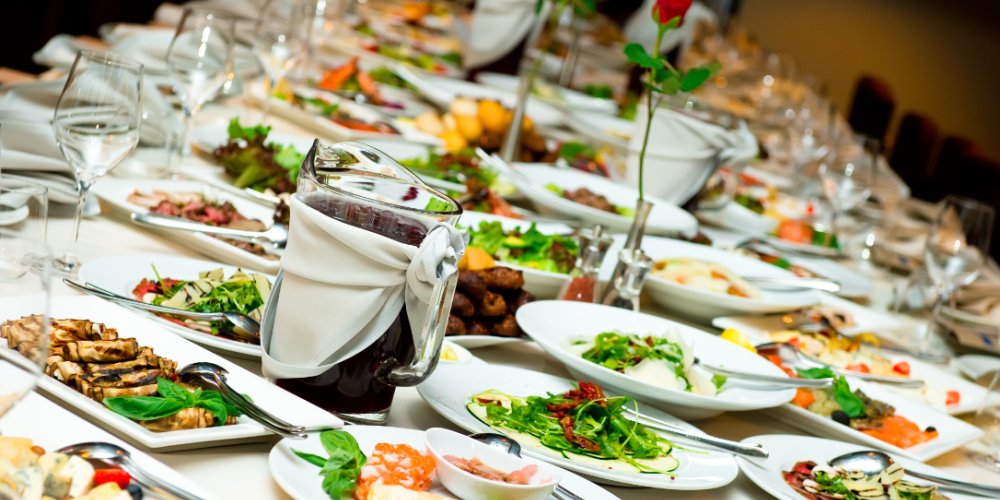
Our food culture is evolving at a rapid pace. Even when it comes to parties. We love having a lot of good food and beverages. For reference within the field, Emeritus Professor Dr Peter Scholliers of the VUB keeps a finger on the pulse. He examines the eating habits of the past decades and today. 'We really let ourselves go during parties. That is what is expected of us.'
Text: Stephanie Demasure
In the 1920s, the aperitif concept was the novelty par excellence. Italian cuisine was introduced to festive menus in the 1960s. In the 1990s, fondue returned as the ultimate classic. 'Every decade has its own trends', says Dr Emeritus Professor Peter Scholliers. 'Festive meals often set the tone for what later becomes normal or Sunday food. Even today. It is striking that the changes follow each other ever-more rapidly.' Just like decorating for a party. Because it is no longer limited to the table: a festive meal has become a total event.
Continue reading below the picture.
 Photo: Saskia Vanderstichele
Photo: Saskia Vanderstichele
Attention in specialized magazines
Someone who previously wanted to put a festive meal on the table as a good hostess was not left to her own devices. From the early 1920s, specialized magazines focused on food culture. Fortunately. Today, such publications are a valuable resource for scientific researchers such as Professor Scholliers. 'Just like Ons Kookboek, by the way, first appeared in 1927. Nearly everyone today has a copy in the kitchen. Ons Kookboek focused in the 1950s and 1960s on the traditional and the abundant.'
In particular, the copious nature of festive meals has stood out since the 1950s. After a period of relative scarcity, there is suddenly an abundance of food and beverages. People compensated for the shortages suffered, certainly on special occasions such as Christmas Day or New Year's Eve. 'That abundance has remained since then. You are almost forced to eat and drink (too) much at parties. What appears on your plate has, of course, continued to evolve.'
You are almost forced to eat and drink (too) much at parties.
Turning point in the nineties
If the party menu was fairly traditional up to the 1980s, with new nuances here and there, then everything changed in the 1990s. Peter Scholliers illustrates this with the bread trends, a theme about which he is currently writing a book. 'Until then everyone ate white bread. Boring bread, we can say. A number of people suddenly start eating other types of bread. For variation and creativity, for health reasons... The demand for delicious bread grew. As we begin the new millennium, the bread revolution is everywhere. Bakers and later also department stores have started to offer tastier varieties and organic bread. A taste revolution in the making.'
While the trends follow each other at a rapid pace, people are increasingly turning back to tradition and authenticity. 'In 2018, every lifestyle magazine and every weekend supplement of newspapers hammered at parties with a focus on their own region. Are we serving a tomato-shrimp dish? Then we get the fresh shrimp ourselves in the harbour. Although we can ask ourselves what exactly authenticity means. Are those tomatoes from your own greenhouse or tomatoes from Italy?' At any rate: with what appears on the table, you show friends and acquaintances that you are doing well. Also for those whom you see infrequently throughout the year.
In 2018, every lifestylemagazine and every weekend supplement of newspapers hammered at parties with a focus on their own region.
Parties set the trend
Just like innovation in restaurants inspires parties, they in turn are a trendsetter for Sunday food and even weekday meals. Look back at the fondue hype from some 30 years ago. Then, it was typical dining for a special day. A few years later, many Belgian households also took out the fondue set on a normal weekend day. 'The same with, for example, Thai or Chinese food', the professor adds. 'What used to be an exotic feast has today become almost standard take away. Sushi is a striking example of this.'
What used to be an exotic feast has today become almost standard take away.
It may surprise you, but there are no strong regional differences in Belgium. Even though the cultures often differ widely, certainly in the capital Brussels. In the three regions, Christmas Eve is more of a family affair, while the New Year is celebrated with friends. In Brussels, it is mainly the ethnic restaurants, abundantly present, that do well on such an evening.
And since we are focusing on Brussels: what about the Belgian royal family? What does a royal celebration look like? That is like reading coffee grounds, even for Professor Scholliers. 'The royal family is very discreet about what's on the table', he says. 'You can find some information about the eating habits on holidays in the archive. Especially in the first half of the 20th century. There was abundant food on those days, but not noticeably different than on a weekday. A princess did write in her biography that she was happy about the delicious dessert on a holiday. Don't we all recognize ourselves in that a bit?'
--
Dr Peter Scholliers is Professor Emeritus in socio-cultural history and author of the book Food culture in Belgium (Westport & London, 2008), part of a worldwide book series about national food culture. He was affiliated with the Fund for Scientific Research for many years and is active at the VUB.
--
You can find all articles of the festive magazine here.